1. Upper incisors present; body shape pig-like; canines elongate: 2
1'. Upper incisors absent; body not pig-like; canines not elongate; no upper incisors: 3
2. Upper and lower canines curved up and out; dental formula 3/3 1/1 4/4 3/3 = 44: Sus scrofa
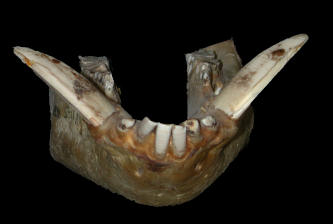
Anterior view of the lower jaw of the domestic pig (Sus scrofa. Note the large canines curving out and up.
2'. Canines nearly straight; dental formula 2/3 1/1 3/3 3/3 = 38: Pecari tajacu.
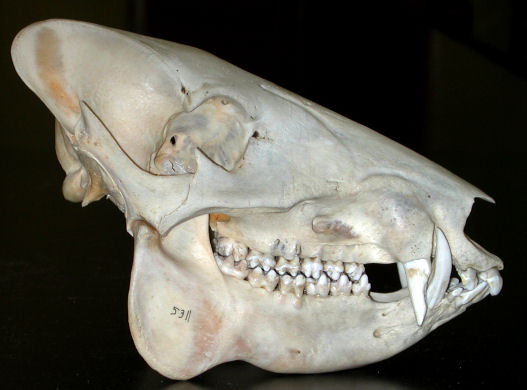
Lateral view of the skull of the Collared Peccary (Pecari tajacu. Note the upper canines pointing down and the lower canine pointing almost straight up.
3. Males with antlers (females without antlers or horns); a large antorbital fenestra; lateral digits present: Cervidae, 7
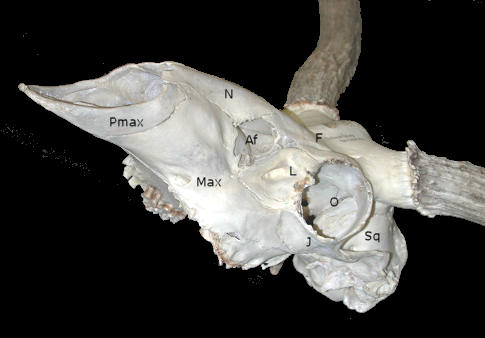
Skull of a male Mule Deer (Odocoileus hemionus). Label abbreviations are Pmax = Premaxilla Max = Maxilla N = Nasal Af = Antorbital fenestra L = Lacrimal F = Frontal O = Orbit J = Jugal Sq = Squamosal.
3'. Males and females with horns (a keratinized sheath supported by a bony horn core extending from the frontal); large antorbital fenestra absent, or if present, lateral digits lacking or vestigial: 4
4. Horns forked; antorbital fenestra present; lateral digits absent or vestigial: Antilocapra americana.
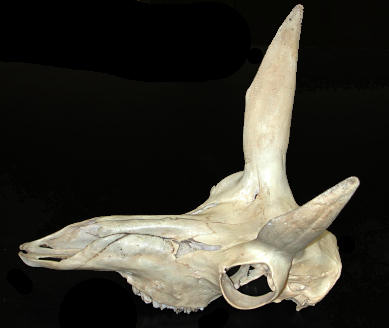
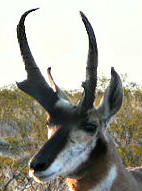
Left. Skull of Pronghorn (Antilocapra americana). A relatively small antorbital fenestra is visible. The large projections from the skull are the horn cores. Top. Head of a Pronghorn showing the small anterior branch on the horn.
4'. Horns not forked; antorbital fenestra absent; four hooves (including two vestigial hooves) on each foot: 5
5. Horns smooth and directed laterally and dorsally, slanting somewhat posteriorly; cow-sized; dark brown in color: Bison bison.
5'. Horns with annular ridges, posteriorly curved; sheep-sized: 6
6. Males with midventral mane of hair on neck: Ammotragus lervia.
6'. Males without midventral mane on neck: Ovis canadensis.
7. Antlers with a prominent brow tine; upper canines present; vomer not attached to medial suture of palatines, not separating posterior narial cavity; prominent yellow rump patch: Cervus elaphus.
7'. Antlers without prominent brow tine; upper canines absent; vomer attached to medial suture of palatines, completely separating narial cavity; no large yellow rump patch: 8
8. Tail white, tipped with black tuft; antlers branched dichotomously, anterior and posterior beams nearly equal: Odocoileus hemionus.
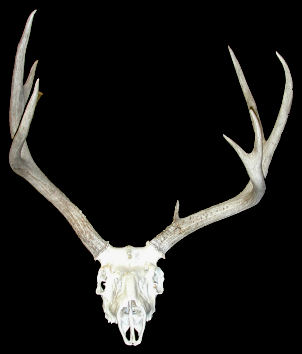
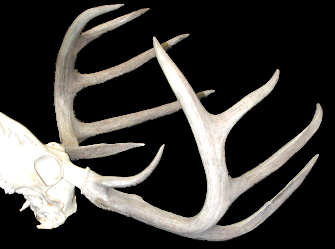
Left: Skull of Mule Deer Odocoileus hemionus buck showing the dichotomous antlers. Right: Skull of White-tailed Deer Odocoileus virginianus buck showing the non-dichotomous antlers.
8'. Tail white below, brown above; antlers with one main anteriorly directed beam with smaller tines branching dorsally from it: Odocoileus virginianus.
Key slightly modified from Findley (1987).
Last Update: 2 Feb 2008